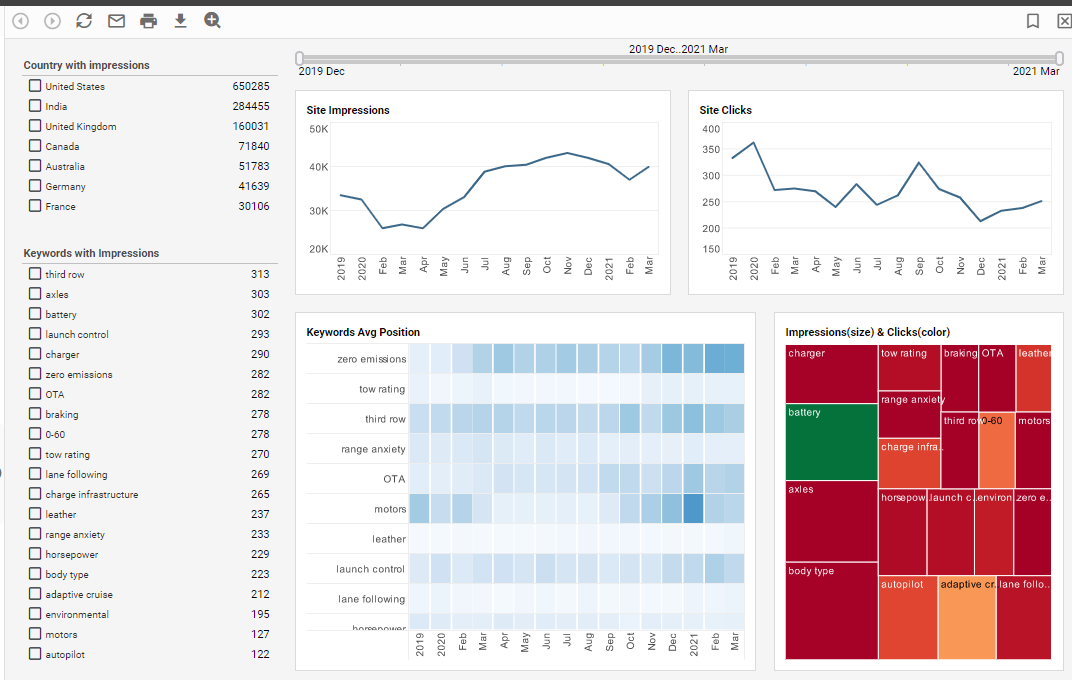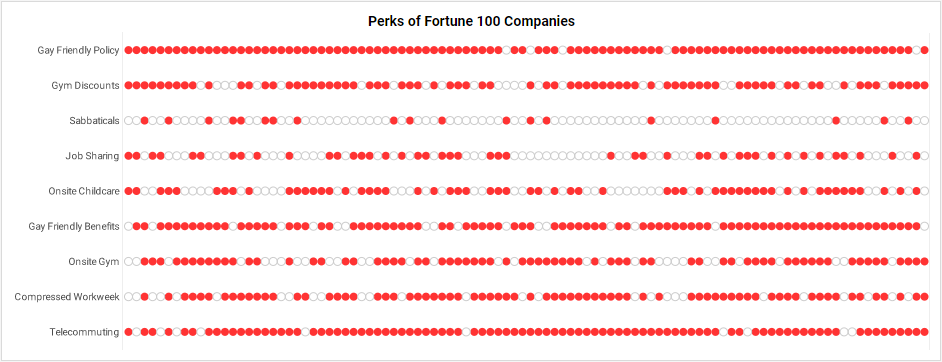Looking for Easy, Yet Effective Reporting Software?
InetSoft offers easy reporting software without sacrificing functionality.
With InetSoft's Style Report, reports can be created easily using a simple drag and drop interface. Users with excel-level skills can build and customize their own reports, without help from IT.
This reporting process can be fully automated, producing reports at regular time intervals or when certain business conditions are met.
Additional functionality, such as drilldown and bursting, enables the specifics in a reports data to be explored.
Style Report also includes a charting library with over 30 different chart types, to present organizational data in an intuitively visual way.


InetSoft's Easy Reporting Tool Includes Data Mashup
With InetSoft's robust data mashup engine, reports can be created with data pulled from many disparate sources in real time whether they are on premise or in the cloud. Information that would have been previously presented in multiple reports can now be consolidated into one.
Data sources that can be accessed include relational databases (JDBC), multidimensional databases, JSON and REST API, XML, SOAP, Java beans (POJO), Microsoft Excel, CRMs such as Sugar and Salesforce, specialized app such as Survey Monkey and Google Ads.
InetSoft's easy reporting tool also features a data grid cache, which automatically updates itself from data sources at a regularly scheduled time.
The report wizard also allows users to create their own ad hoc reports to answer specific needs, without help from IT.
From Looker to Serverless: How a Solar Panel Manufacturer Cut Reporting Costs by 60% with InetSoft's Microservice Architecture
As renewable energy companies scale rapidly to meet growing global demand, their business intelligence and reporting infrastructure must evolve accordingly. SolarTech Industries, a mid-sized solar panel manufacturer based in California, recently completed a comprehensive migration from Google Looker to InetSoft's serverless reporting microservice, achieving significant cost savings while dramatically improving system performance and user satisfaction.
The migration, completed over a six-month period, demonstrates how modern serverless architectures can address the scalability, cost, and maintenance challenges that plague traditional BI platforms in high-growth manufacturing environments.
The Challenge: Looker's Limitations in a Scaling Environment
SolarTech Industries had been using Google Looker for three years to support reporting across manufacturing operations, supply chain management, quality control, and financial analytics. As the company grew from 200 to 800 employees and expanded production capacity by 300%, several critical issues emerged with their existing Looker implementation.
The primary challenge was licensing costs that scaled linearly with user growth. SolarTech was paying $3,000 per month for their Looker Standard plan, which included 25 users. As their reporting needs expanded to include shop floor supervisors, quality control technicians, and regional sales managers, additional user licenses at $30 per month quickly became prohibitive. The company projected annual Looker costs would exceed $75,000 by 2025.
Performance issues compounded the cost concerns. Looker's query processing became increasingly sluggish as data volumes grew, with complex manufacturing reports taking 3-5 minutes to render during peak usage periods. The platform's inability to handle concurrent users efficiently meant that critical operational reports were often unavailable when needed most.
Evaluating InetSoft's Serverless Architecture
SolarTech's IT team, led by Director of Information Systems Maria Rodriguez, began evaluating alternatives in early 2024. InetSoft's serverless reporting microservice emerged as the leading candidate due to its fundamentally different approach to licensing, resource management, and system architecture.
Unlike Looker's per-user model, InetSoft's serverless solution operates on a consumption-based pricing structure that charges based on actual compute resources used rather than the number of users accessing reports. This model aligned perfectly with SolarTech's variable reporting patterns, where usage spikes during monthly production reviews and remains minimal during off-peak periods.
The serverless architecture also promised to eliminate the infrastructure overhead that had become increasingly problematic with Looker. InetSoft's microservice approach automatically scales compute resources up or down based on demand, ensuring consistent performance without the need for capacity planning or infrastructure management.
Migration Strategy and Implementation
SolarTech adopted a phased migration approach, beginning with non-critical financial reports before moving to mission-critical manufacturing dashboards. The IT team worked closely with InetSoft's professional services team to develop a comprehensive migration plan that minimized business disruption.
The first phase involved migrating 15 financial and sales reports over a two-month period. This allowed the team to familiarize themselves with InetSoft's development environment while validating the platform's ability to handle SolarTech's data integration requirements. The company maintains data warehouses in both PostgreSQL and MongoDB, with real-time manufacturing data streaming from various IoT sensors and production equipment.
InetSoft's native support for multiple data sources proved invaluable during this phase. The platform's API-first architecture enabled seamless integration with SolarTech's existing data pipeline, while built-in connectors eliminated the custom middleware that had been necessary with Looker.
The second phase focused on operational reporting, including quality control dashboards, production scheduling reports, and supply chain analytics. This phase required extensive collaboration with end users to ensure that the new reports met or exceeded the functionality of their Looker predecessors. The serverless architecture's ability to handle real-time data streams proved particularly valuable for shop floor dashboards that monitor production line efficiency and equipment status.
Technical Implementation Details
From an architectural standpoint, the migration involved deploying InetSoft's reporting microservice within SolarTech's existing AWS infrastructure. The serverless design integrates seamlessly with AWS Lambda, S3, and RDS services, leveraging existing security policies and network configurations.
The implementation team configured auto-scaling policies that automatically provision additional compute resources during peak reporting periods, such as end-of-month production reviews or quarterly business reviews. This dynamic scaling capability ensures consistent performance while minimizing costs during low-usage periods.
Cost Analysis and Resource Savings
The financial impact of the migration exceeded initial projections. SolarTech's monthly reporting costs dropped from $3,800 (including user licenses and infrastructure) to $1,500, representing a 60% reduction in total cost of ownership. The consumption-based pricing model proved particularly advantageous, as the company's variable reporting usage patterns aligned well with the pay-per-use structure.
- Licensing: $2,400/month savings (eliminated per-user fees)
- Infrastructure: $600/month savings (no dedicated server requirements)
- Maintenance: $300/month savings (reduced administrative overhead)
- Total Monthly Savings: $3,300
- Projected Annual Savings: $39,600
Beyond direct cost savings, the serverless architecture eliminated several categories of operational overhead. The IT team no longer needs to monitor server capacity, plan for peak usage scenarios, or maintain backup infrastructure. Software updates and security patches are handled automatically by InetSoft's platform, reducing administrative burden by an estimated 15 hours per month.
Performance and Scalability Improvements
The performance improvements were immediately apparent following the migration. Complex manufacturing reports that previously required 3-5 minutes to render now complete in 15-30 seconds, even during peak usage periods. The serverless architecture's ability to dynamically allocate compute resources ensures consistent performance regardless of concurrent user load.
Query response times improved by an average of 75% across all report categories. Real-time production dashboards, which are critical for monitoring manufacturing efficiency, now update every 30 seconds compared to the 5-minute refresh intervals that were necessary with Looker due to performance constraints.
The scalability benefits extend beyond performance to user access. SolarTech can now provide reporting access to all employees who need it without incurring additional licensing costs. This democratization of data access has led to improved decision-making at all levels of the organization, from shop floor supervisors to executive management.
User Satisfaction and Management Response
End-user satisfaction surveys conducted six months post-migration revealed significant improvements across all user categories. Manufacturing supervisors particularly appreciated the improved performance of real-time production dashboards, while finance team members highlighted the enhanced customization options available in InetSoft's platform.
Management satisfaction centered primarily on the cost savings and improved system reliability. CFO James Chen noted that the elimination of per-user licensing costs allows the company to provide data access to employees who previously couldn't justify the cost, leading to more informed decision-making throughout the organization.
The IT team reported high satisfaction with the reduced administrative overhead and improved system stability. Director Rodriguez emphasized that the serverless architecture allows her team to focus on strategic initiatives rather than routine maintenance and capacity planning.
Support and Service Experience
The migration process highlighted significant differences in support quality between the two platforms. While Google's support for Looker followed a standard enterprise model with ticket-based responses and limited direct technical assistance, InetSoft provided dedicated migration support including direct access to platform architects and custom integration assistance.
Post-migration support has exceeded expectations, with average response times of less than four hours for technical issues and same-day resolution for most problems. The availability of direct technical support has proven particularly valuable for optimizing report performance and implementing advanced features.
Lessons Learned and Future Outlook
SolarTech's migration experience offers several key insights for organizations considering similar transitions. The consumption-based pricing model works particularly well for companies with variable reporting usage patterns, while the serverless architecture provides significant advantages for organizations that lack extensive BI infrastructure expertise.
The company plans to expand their use of InetSoft's platform to include predictive analytics for equipment maintenance and advanced supply chain optimization. The platform's API-first architecture and integration capabilities position it well to support these advanced use cases as SolarTech continues to scale their operations.
Looking forward, the successful migration has established InetSoft as SolarTech's strategic reporting platform, with plans to integrate additional data sources and develop more sophisticated analytics capabilities. The cost savings achieved through this migration are being reinvested in advanced manufacturing technologies and expanded production capacity, directly supporting the company's continued growth in the renewable energy sector.
For IT leaders considering similar migrations, SolarTech's experience demonstrates that modern serverless architectures can deliver significant improvements in cost, performance, and operational efficiency when properly implemented and supported by experienced platform providers.

